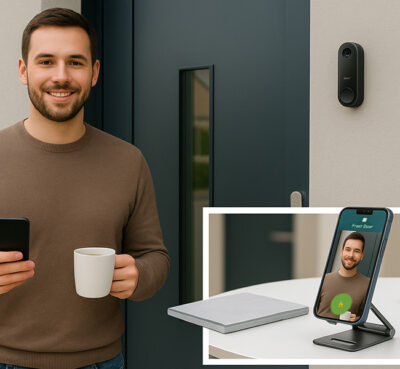Picture this:
It’s a typical weekday at the office.
People rushing around like they’re late for a rocket launch.
The doors? Flimsy, auto-closing panels – more IKEA than industrial.
Securing them? A “high-security” lock that barely keeps out a breeze.
But the real centerpiece?
The Almighty Access Control System (ACS).
A solution so bloated and expensive, you’d think it was guarding a missile silo, not a shared workspace.
IT swears by it.
Finance dreads it.
And no one really knows what it actually does.
The Budget Bloodletting
Here’s what it takes to get in on the ACS game:
- A 20-page project plan just to confirm the door exists
- Cabling – routed through every concrete beam and ceiling tile
- A “special” lock, marked up because it came from a Fortune 500 catalog
- A badge reader, a controller, a clunky license, and software that belongs in a tech museum
- Cards, fobs, stickers, badge printers… and someone to manage the mess
- An admin who can bring the system back to life through sheer force of habit
- And of course – the sacred monthly access control fee. Without it, the system still runs… but with a guilty conscience
Welcome to the club.
Feeling secure yet?
Who’s Actually Getting In?
Using NFC? Great – a phone beeps, the door unlocks.
Only issue? A phone isn’t a person.
Here’s How That Plays Out:
A popular gym rolls out NFC access.
Members just tap their phones. Smooth, right?
Until someone buys a cheap Android phone, activates their membership, and passes it around.
Now a dozen freeloaders are working out on one paid account.
The system logs it as the same member showing up daily.
Now picture that in your office.
The log says John is in.
But John’s home, sleeping off last night’s party.
John’s girlfriend – and coworker – Sarah borrowed his phone, and now she’s cruising the halls like he clocked in.
“Just Add Cameras!”
Sure, in theory.
But let’s face it:
- The manager reviews footage only when someone steals lunch
- The sysadmin checks it when the cameras go dark
- Everyone else ignores it
CCTV is great for reviewing incidents –
but completely useless in the moment when you need to allow or deny access.
So Why Are We Still Buying Readers?
If there’s already a camera above the door – or a cheap Android phone nearby – why spend more on badge readers and controllers?
That camera can do double duty and also scan:
- Face ID for staff
- QR codes for guests
- A simple RTSP stream or selfie cam – not a $300 Frankenstein box
The goal was never to track devices.
It was to control access for people.
What If We Simplified It?
- Project plan? Skip it. We know where the doors are
- Cabling? Not necessary – Wi-Fi and BLE do the job
- $800 lock? Swap it for a smart Bluetooth deadbolt
- Reader and controller? Replace them with a $50 camera or Android device
- Cards and fobs? Ditch them. Use QR or Face ID
- Sysadmin? Let them handle actual tech problems
- Monthly fees? No thanks – one license, done
What You Actually Get:
Not an overpriced gadget maze.
Just a clean, intelligent solution that gives access to the right people, not just the right gear.


